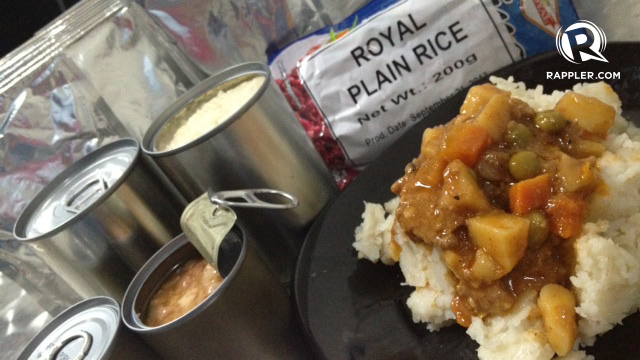
INSTANT FOOD.
Soldiers and police deployed in Samar and Leyte
are subsisting on ready-to-eat meals that do not spoil for one year. Photo by
Cecille Santos/Rappler
Soldiers and police deployed in Samar and Leyte to maintain order and help in the relief and recovery efforts are subsisting on ready-to-eat meals (REMs) that do not spoil for a year.
These REMs may also temporarily help solve the problem of creeping starvation among hundreds of thousands of victims and survivors of Super Typhoon Yolanda (Haiyan) in Eastern Visayas.
The Armed Forces has already ordered 10,000 sets of REMs for soldiers deployed in Samar and Leyte, with the National Police ordering a separate 6,000 sets. One set consists of 3 meals good for one day, with each meal having 250 grams of rice and 200 grams of a viand.
Initially meant for soldiers deployed in remote areas, REM is a two-in-one combo of rice and viand that does away with cooking preparations.
It was developed only this year by businesswoman Jo Magcale, and was first delivered to the Army as part of its food provision for soldiers deployed in Zamboanga City.
They stayed for about a month after a faction of the Moro National Liberation Front laid siege to the city.
“We’re already getting inquiries from private donors for the purchase of REMs.
Instead of sending clothes, noodles, canned goods, or clothing, this is one stop-gap measure to readily address hunger in Eastern Visayas,” Magcale, president of Soul of David Corp, said.
“Taga-bitbit ng kaldero”
Magcale came up with the idea of REMs after soldiers deployed in remote and rebel-infested areas complained that they could not afford a decent meal during operations.
“In the Army, one is assigned as the taga-bitbit ng kaldero at bigas (rice pot carrier). They said it is a bother to cook food. They need also water. Besides, cooking is a security risk. It may give away their location,” Magcale said.
“They also complained that they do not have a decent meal for days, with the meager food allowance allocated for soldiers.”
A soldier has a monthly food allowance of P2,700 or P90 a day. This means that they only have P30 for each breakfast, lunch and dinner meal.
The REM is an apparent adaptation of the US’ "Meal, Ready to Eat" (MRE), which are rations for American soldiers sent to the field or to combat zones where cooking facilities are not available. An MRE may consist of a main course, side dish and dessert, with each meal containing the calorie requirement for an American soldier.
Magcale however said the US military’s MRE does not fit the Filipino concept of what constitutes a meal. “When we say meal, there’s rice and at least one kind of viand. Without rice, that is not a meal.”
Tested by DOST
Conscious of the soldier’s daily food budget, Magcale managed to work around the overhead cost and came up with a pricing scheme that suits the soldier’s needs. Meals in foil packs are priced P30 while those in can are priced at P40.
“There’s actually little margin (of profit). It is our way of helping our soldiers in the field,” she said. “We used rice from the National Food Authority and we order by bulk from poultry and hog raisers. That’s how we are able to keep operational costs within our budget.”
However, testing and development of the REM cost almost P1 million. It underwent and passed the standards set by the Department of Science and Technology for food safety. “We do not use preservatives. The rice and viand are cooked in high heat for longer shelf life. Our REM has a shelf life of one year,” she explained.
Ordinary consumers may find the rice a bit drier than normal. This is because the rice had to be “dehydrated” so it won’t spoil easily.
Magcale also came up with different varieties of viand – from adobo to chicken and pork peccadillo, kare-kare, sisig, chicken caldereta, chicken teriyaki, and chicken curry.
The military admitted it initially hedged about sending a large contingent to Tacloban City because of concerns that the troops would only contribute to the food shortage already plaguing the city.
“We also have a problem on the ground with food and water. We might be adding troops that are not needed. Another problem is how to feed the soldiers and policemen we will send there,” National Disaster Risk Reduction and Management Council executive director and retired Army general Eduardo del Rosario was quoted as saying.
In times of crisis and national emergencies, the REM addresses that concern.
http://www.rappler.com/nation/43869-ready-to-eat-meals-war-disaster

No comments:
Post a Comment
Note: Only a member of this blog may post a comment.